Oud's exceptional blending power comes from its complex molecular structure containing sesquiterpenes that create strong bonds with other fragrance compounds. You'll find it works beautifully with everything from light florals to deep woods thanks to its multiple binding sites and structural flexibility. It's also a natural fixative, enhancing the longevity of other scents while adding luxurious depth. Understanding oud's chemical makeup and versatility will reveal countless possibilities for creating unique fragrance combinations.
The Chemistry Behind Oud's Blending Power

While many fragrances offer distinct scent profiles, Oud's exceptional blending power stems from its intricate molecular composition. You'll find a complex array of sesquiterpenes, including alpha agarofuran and 3-phenyl-2-butanone, that create its signature scent.
What makes Oud particularly versatile is its diverse range of volatile compounds, which naturally complement both synthetic and natural fragrance ingredients. These chemical constituents don't just contribute to the scent; they also act as fixatives, helping your perfume last longer on your skin. The addition of Oud Asafi material produces an especially luxurious depth that enhances the overall fragrance profile.
The varying compositions of different Oud types let perfumers tailor their creations to specific fragrance profiles. The synergistic effects of Oud's chemical components enhance the overall depth of your perfume, creating harmonious blends that are greater than the sum of their parts.
Understanding Oud's Natural Compatibility
Oud's remarkable molecular structure allows it to form strong bonds with various fragrance compounds, making it a versatile player in perfumery.
You'll find that its complex chemistry creates multiple binding sites that can interact with different scent molecules, from light florals to deep woods.
This unique structural flexibility explains why you can successfully pair oud with such a wide range of fragrance notes, creating harmonious blends across different scent families.
As demonstrated in the fragrance composition, the combination of oud with bergamot and cedar creates an especially compelling opening that showcases this adaptability.
Molecular Structure and Bonds
Understanding the molecular structure of oud-compatible compounds reveals why certain fragrances blend so naturally with this precious resin. At the core of this compatibility are 3-(lower alkyl)phenols, particularly compounds like 3-(n-propyl)phenol and 3-ethylphenol, which feature specific molecular arrangements that create the distinctive oud character.
You'll find that these compounds aren't just passive ingredients; they actively enhance the animal aspects and warm tonalities of your oud blends. The aromatic compounds deliver a sweet and balsamic profile that defines authentic oud's character.
When R1 is a hydrogen atom and R2 is a methyl group, you get the perfect 3-(n-propyl)phenol structure that's essential for authentic oud character.
What's remarkable is how these molecules create exceptional synergy with other fragrance elements, making your blend more truthful to natural oud while maintaining stability in various formulations.
Scent Profile Versatility
Beneath its complex molecular structure lies an extraordinary versatility that makes oud one of perfumery's most adaptable ingredients.
You'll find oud's scent profile unfolds like a symphony, revealing layers of sweet, balsamic, earthy, and woody notes that seamlessly blend with various fragrance families.
When paired with florals, particularly rose, oud creates a harmonious balance between depth and delicacy.
It's equally impressive with fresh herbs, citrus notes, and oriental spices, each combination showcasing a different facet of its character.
Whether you're seeking a mysterious animalic scent or a tender sweet blend, oud adapts beautifully to create distinct fragrance styles.
You can experience oud's versatility in both bold, standalone fragrances and more nuanced blends, where it adds richness while maintaining perfect harmony with its companion notes.
Essential Building Blocks of Oud Combinations
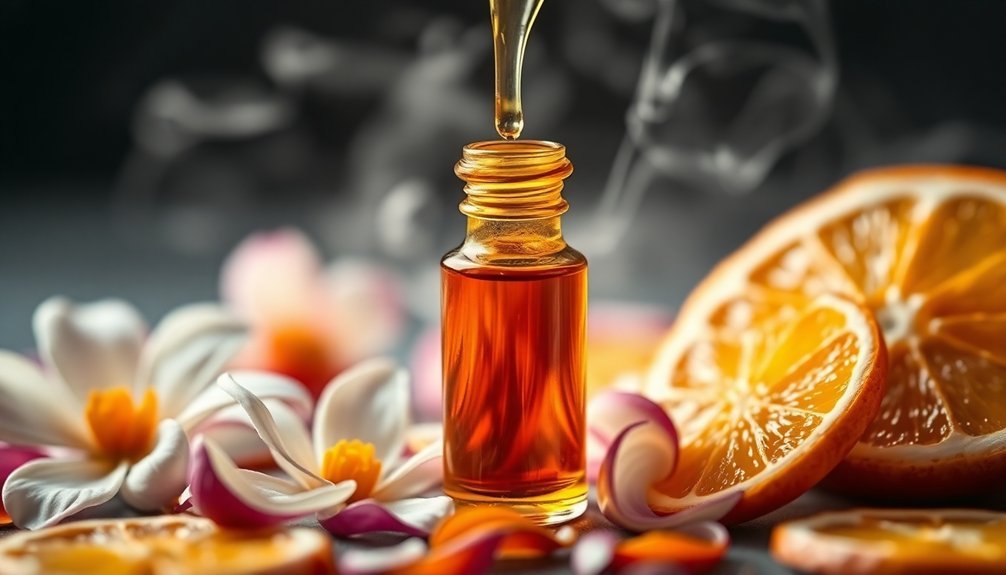
The art of blending oud fragrances relies on several key building blocks that create a harmonious composition.
You'll find that starting with multiple oud bases can provide the complex foundation needed for a sophisticated scent. When you're building your blend, consider incorporating complementary woods like sandalwood and cedarwood, which enhance oud's natural characteristics while adding their unique profiles.
For depth and longevity, you'll want to include musks like ethylene brassylate or velveton, which help bind the fragrance together and boost its performance.
Don't overlook the power of incense notes – frankincense and styrax can add compelling top and middle layers.
Finally, woody amber accords and vanillin can round out your composition, creating a sweet, warm base that perfectly complements oud's rich, earthy nature.
Mastering the Art of Oud Layering
When layering with oud, you'll want to start with a strong base note that anchors your fragrance combination and provides lasting power throughout the day.
You can achieve the perfect blend by selecting complementary scents that work in harmony with oud's rich profile, such as florals or light woody notes.
For the most balanced results, you'll need to apply your fragrances in proper proportions, starting with the strongest note first and gradually building up with lighter scents.
Base Notes Matter Most
Creating a masterful oud fragrance begins with understanding its base notes, which serve as the foundation for any successful blend. Oud's deep, woody aroma provides the perfect anchoring point for other scents, offering both longevity and sophistication to your fragrance composition.
When you're working with oud, you'll want to embrace its natural partnership with complementary base notes like cedarwood, sandalwood, and vetiver. These earthly tones enhance oud's inherent depth while creating a more complex and grounded scent profile.
The addition of leather notes can introduce a subtle smokiness that adds warmth to your blend. Remember that oud's base notes aren't just about depth – they're about creating a stable foundation that allows other fragrance notes to shine while maintaining their own distinct character.
Complementary Scent Selection Process
Mastering oud layering requires a systematic approach to selecting complementary scents that enhance its rich, complex character. You'll find that floral notes like rose and jasmine work exceptionally well with oud's deep profile, creating a harmonious blend that's both sophisticated and balanced. When selecting your complementary fragrances, focus on creating a progression of notes that seamlessly shift from top to base.
| Scent Type | Best Pairs with Oud | Application Tip |
|---|---|---|
| Floral | Rose, Jasmine | Light spritz only |
| Woody | Sandalwood, Cedar | Apply at pulse points |
| Oriental | Vanilla, Amber | Layer before oud |
| Fresh | Bergamot, Citrus | Use sparingly |
| Spicy | Saffron, Cardamom | Test on paper first |
Start with lighter scents and gradually build up to heavier notes, ensuring each layer complements rather than competes with oud's distinctive character.
Perfect Proportions For Layering
The perfect balance of fragrances starts with understanding the delicate art of proportions in oud layering. When combining oud with other scents, you'll want to start with a single spray of your oud-based fragrance on your pulse points, as it's a powerful base note that anchors the blend.
Apply your second fragrance immediately after the oud, before it dries, to guarantee seamless blending. Don't wait between applications, as this can disrupt the fusion of scents.
You'll achieve the best results by applying both fragrances to warm areas of your skin, such as your wrists, neck, and behind your ears.
Remember to test your combinations first on a small patch of skin, and be mindful of any scented products you're already wearing, as they could affect the final blend.
Top Notes That Enhance Oud's Character
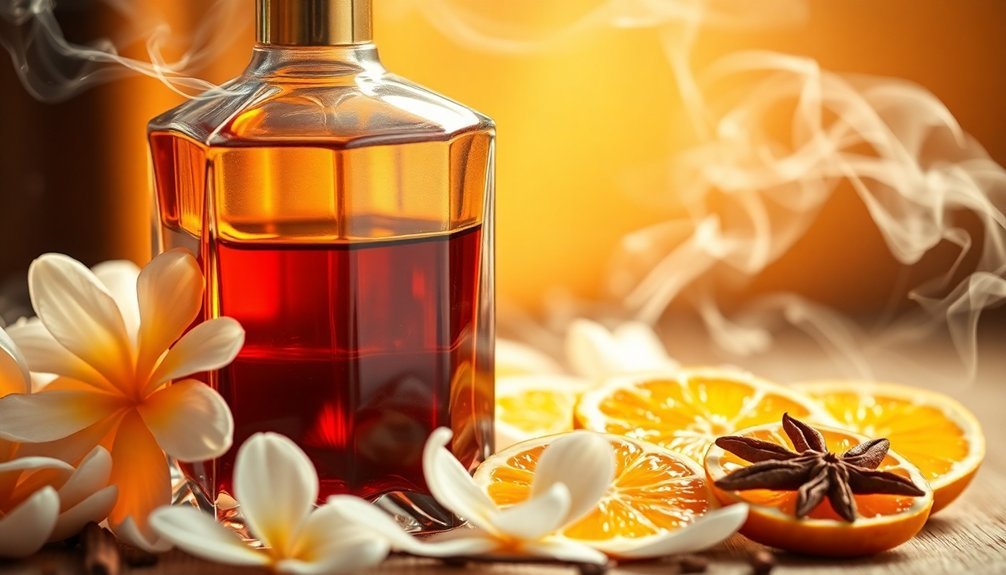
When blending with oud, selecting the right top notes can transform an ordinary fragrance into an extraordinary olfactory experience.
You'll find four main categories that work exceptionally well with oud's intense character.
Citrus and aromatic notes like bergamot and lime create a fresh burst that balances oud's earthiness.
Spicy and herbal elements, including coriander and saffron, add warmth and complexity while complementing oud's natural profile.
If you're seeking elegance, floral notes such as rose and jasmine introduce a softer, more romantic aspect that beautifully contrasts with oud's darkness.
For a revitalizing touch, green and fresh notes featuring grapefruit, blackcurrant, or pineapple provide a bright, lively introduction that perfectly layers with oud's smoky depth.
Creating Depth Through Base Note Pairing
Successful base note pairing with oud requires understanding its complex interaction with other foundational scents.
You'll find that woody elements like cedarwood and sandalwood naturally complement oud's earthy character, creating a rich, multilayered foundation.
When you're looking to add warmth, consider blending oud with amber or vanilla, which enhance its natural sweetness while maintaining sophistication.
For a more dramatic effect, you can pair oud with leather notes to amplify its animalic qualities. This combination works exceptionally well for evening wear and formal occasions.
Don't forget that oud's adaptability to individual skin chemistry means you'll need to experiment to find your perfect blend.
Start with small amounts and gradually build up the intensity until you achieve your desired depth and longevity.
Balancing Intensity and Subtlety

Mastering oud's intensity requires a delicate balance between boldness and refinement. You'll find that oud's versatile olfactive spectrum allows you to create fragrances ranging from gentle whispers to powerful statements.
To achieve this balance, start with an eau de parfum concentration for a more approachable experience, especially if you're new to oud blending.
When mixing your fragrances, consider using a 1:1:1 ratio as your starting point, then adjust based on your desired intensity. Test the blend on your skin and observe how it evolves over 4-8 hours.
You can fine-tune the balance by incorporating complementary notes like vetiver or rose, which help temper oud's strength while maintaining its character.
Remember to document your combinations as you experiment, allowing you to replicate successful blends.
Seasonal Considerations for Oud Blending
Your oud blending choices should shift with the changing seasons, moving from rich, deep notes in winter to lighter, invigorating combinations in summer.
In winter, you'll want to embrace intense oud fragrances with oriental undertones that provide warmth and sophistication during formal events.
For summer, you're better off selecting oud blends with citrus or floral notes, applying them sparingly to maintain a subtle yet distinctive presence in the warmer weather.
Winter's Rich Oud Notes
During the cold winter months, oud fragrances take on a particularly luxurious character that pairs perfectly with the season's cozy atmosphere.
You'll find that winter allows you to explore richer, heavier oud blends that might feel overwhelming in warmer weather.
For the best winter experience, try combining oud with vanilla, musk, or amber notes.
These warm combinations create an enveloping scent that's ideal for festive gatherings and intimate indoor settings.
You can also layer your oud with spicy notes like cinnamon or balsamic accents for added depth.
Don't hesitate to apply your winter oud blend more generously, as cold air tends to diminish fragrance intensity.
Popular choices like Tom Ford Oud Wood or Byredo Oud Immortel offer long-lasting performance that'll keep you fragrantly cocooned throughout the winter day.
Summer's Light Oud Pairing
While winter embraces rich oud combinations, summer calls for a lighter approach to this cherished fragrance.
You'll find that oud's versatile nature allows it to adapt beautifully to warmer temperatures, especially when paired with bright, uplifting notes.
For the perfect summer oud experience, consider these invigorating combinations:
- Blend with citrus notes like bergamot or lime for a vibrant daytime scent
- Layer with fresh florals such as rose or jasmine for elegant sophistication
- Mix with tropical forest oud varieties for a naturally lighter feel
Remember to apply your summer oud sparingly and strategically at pulse points.
Using unscented moisturizer as a base will help the fragrance last longer while maintaining its invigorating character.
This approach guarantees you'll enjoy oud's luxurious depth without overwhelming the seasonal ambiance.
The Role of Fixatives in Oud Compositions

Because fixatives serve as the backbone of any lasting fragrance, they play an indispensable role in oud compositions.
When you're working with oud, you'll find that fixatives like benzoin, labdanum, and synthetic alternatives help slow down the evaporation of volatile compounds, ensuring your fragrance maintains its intended character.
You'll discover that different types of fixatives serve unique purposes in your oud blend.
True fixatives physically retard evaporation, while exalting fixatives like musk and vanilla enhance other notes, adding complexity to your composition.
Plant-based options such as patchouli and sandalwood can act as both fixatives and base notes, making them particularly versatile in oud blending.
Time-Tested Oud Blending Ratios
Four essential ratios stand at the heart of successful oud blending, with rose being one of the most critical components to master. When you're working with oud, you'll find that starting with a conservative 5% rose ratio allows you to build the perfect balance.
For Bulgarian and Turkish roses, you'll want to stay within 20-30% to avoid overpowering the blend.
- Begin with a 1:4 ratio (20% rose to oud) for a classic Middle Eastern profile
- Use 5% rose for delicate, modern interpretations that won't overwhelm
- Scale up to 30% only with Taifi rose for deep, nuanced compositions
Remember that your blend will evolve over time, with top notes fading first and oud's woody base notes creating a lasting impression.
Your skin chemistry will ultimately influence how these ratios perform.
Achieving Harmony in Complex Oud Formulations

Moving beyond basic ratios, creating harmonious oud formulations demands a deep understanding of how multiple elements interact.
You'll need to take into account how oud's bold, earthy character evolves throughout the day and interacts with your skin chemistry.
To achieve balance, start with a light application of oud as your foundation, then layer complementary notes strategically.
You can soften oud's intensity with florals like rose or jasmine, while spices such as cardamom add warmth without overwhelming.
For daytime wear, try brightening the blend with citrus notes, or deepen it with vanilla for evening sophistication.
Remember that aging plays an essential role in your formulation's success.
A well-matured oud will blend more seamlessly with other fragrances, creating a more refined and complex aromatic profile that evolves beautifully over time.
Frequently Asked Questions
Can Synthetic Oud Replicate the Same Blending Qualities as Natural Oud?
While synthetic oud can mimic some blending qualities, you'll notice it can't fully replicate natural oud's complex character and dynamic interactions. It's still effective for perfumery but lacks the authentic depth and evolution.
How Does Altitude Affect the Harvesting and Blending Properties of Oud?
You won't find significant altitude effects on oud's properties, as its quality depends more on the natural infection process of Aquilaria trees and skilled harvesting methods than elevation where it's grown.
Why Do Some People Experience Headaches When Wearing Oud-Based Fragrances?
You may get headaches from oud-based fragrances due to overstimulation of your olfactory nerves, allergic reactions to the ingredients, or sensitivity to synthetic compounds and strong concentrations in the perfume.
Does the Age of Oud Affect Its Ability to Blend With Other Notes?
Yes, as your oud ages, it'll blend more smoothly with other notes. You'll notice it becomes more refined and complex, making it easier to mix with various fragrances while delivering a more sophisticated scent profile.
Can Oud Allergies Develop Over Time With Repeated Exposure to Fragrances?
Yes, you can develop oud allergies through repeated exposure, as your body becomes sensitized to the fragrance compounds. Like other perfume allergies, you'll notice symptoms ranging from skin reactions to respiratory issues.
In Summary
You'll find that oud's remarkable blending power comes from its complex molecular structure and adaptable character. Whether you're working with woody, floral, or oriental notes, oud's rich profile guarantees seamless integration. Remember to take into account seasonality, proper ratios, and fixative elements when creating your blends. By mastering these principles, you'll access endless possibilities for crafting unique and harmonious oud-based fragrances.

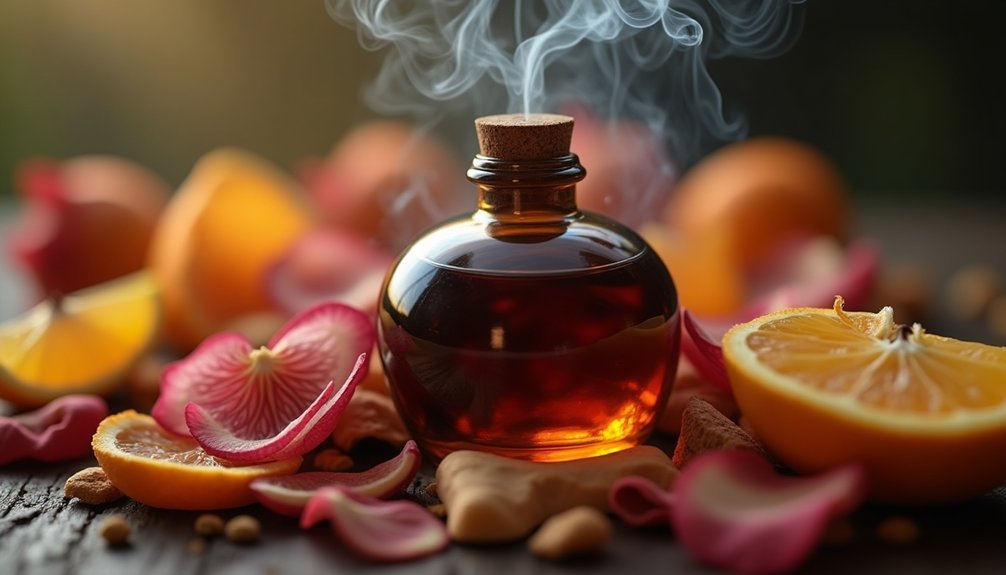
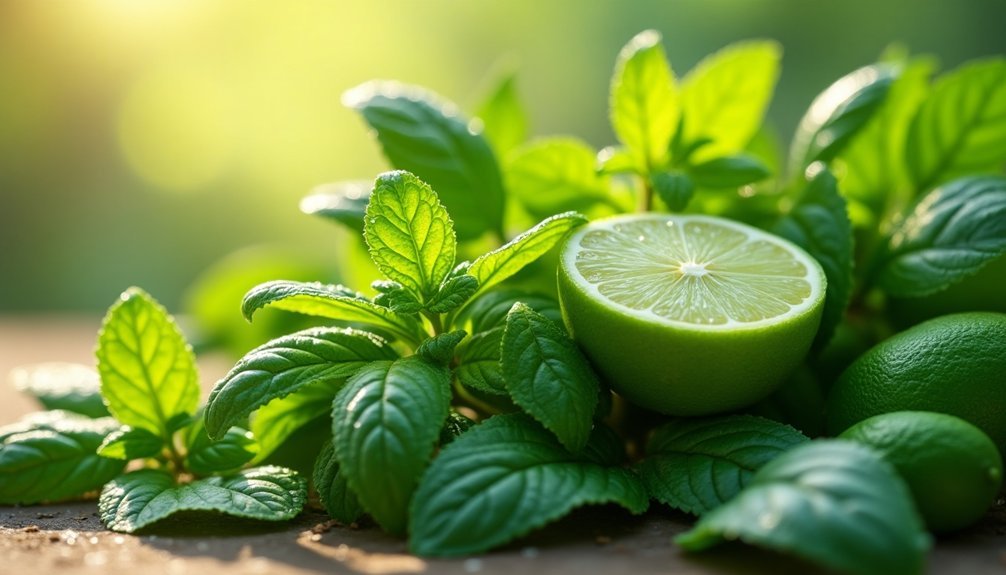
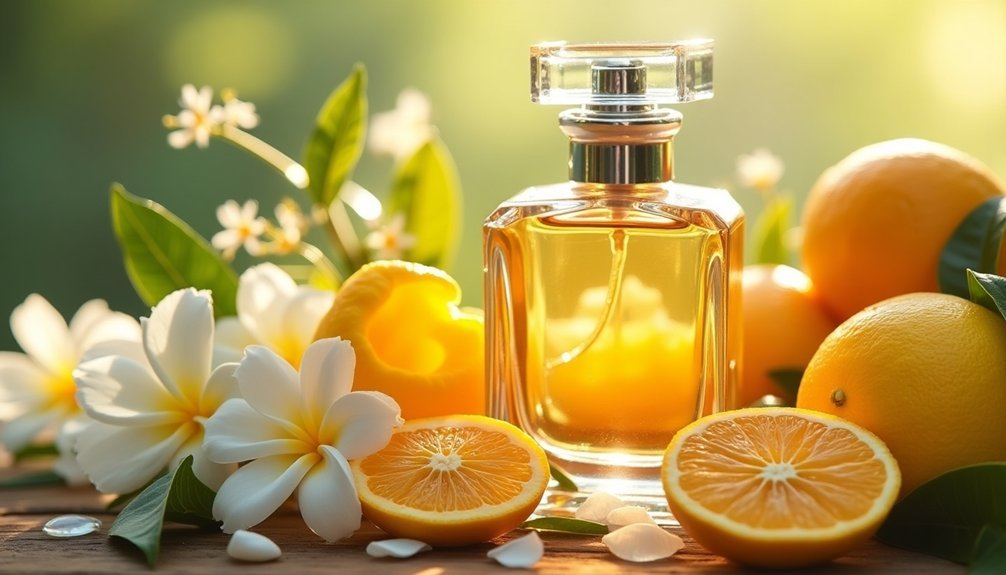
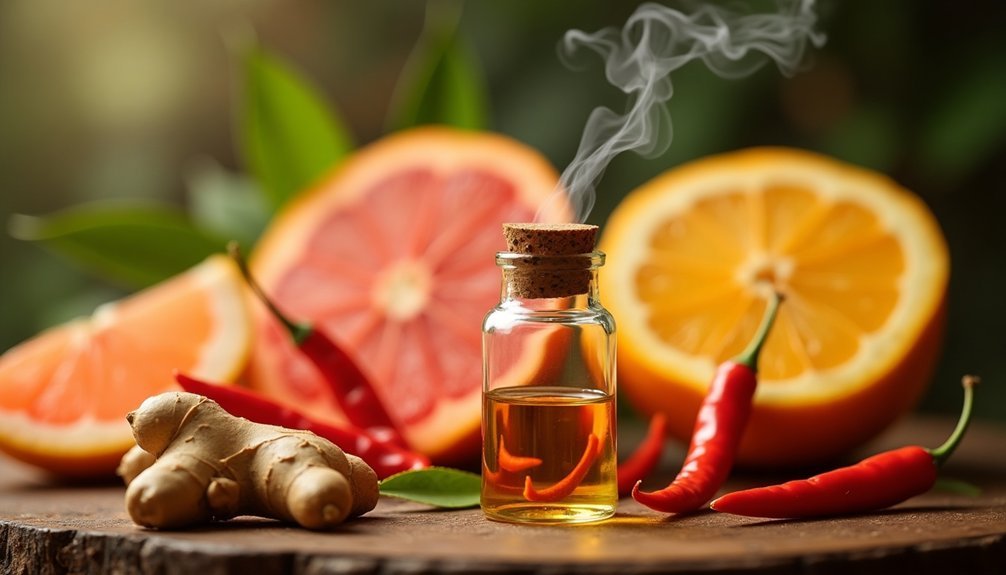
Leave a Reply